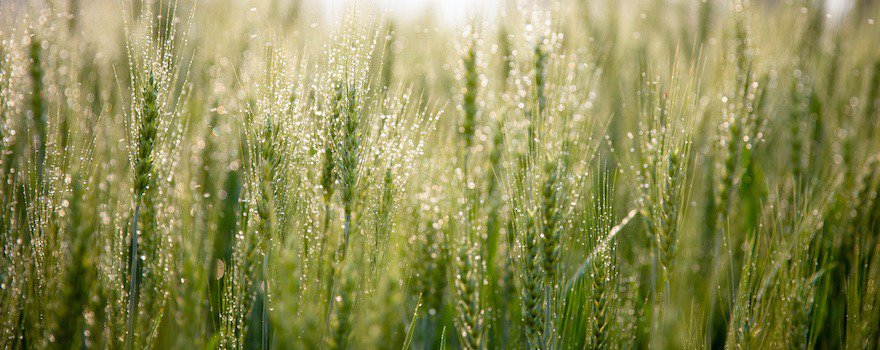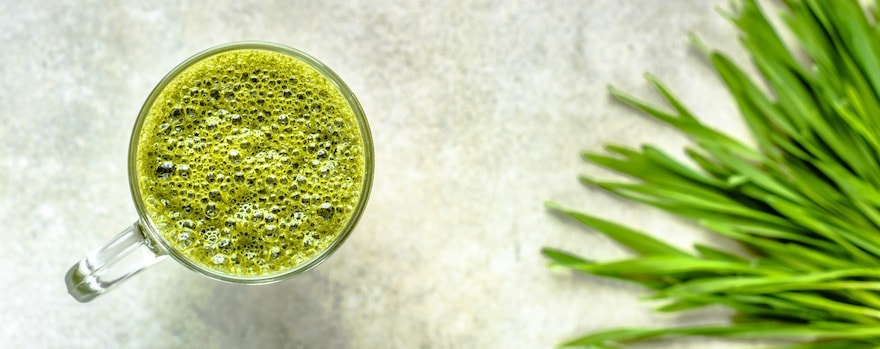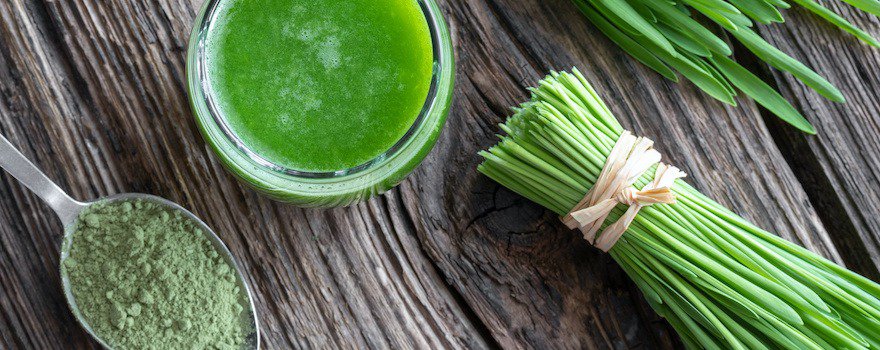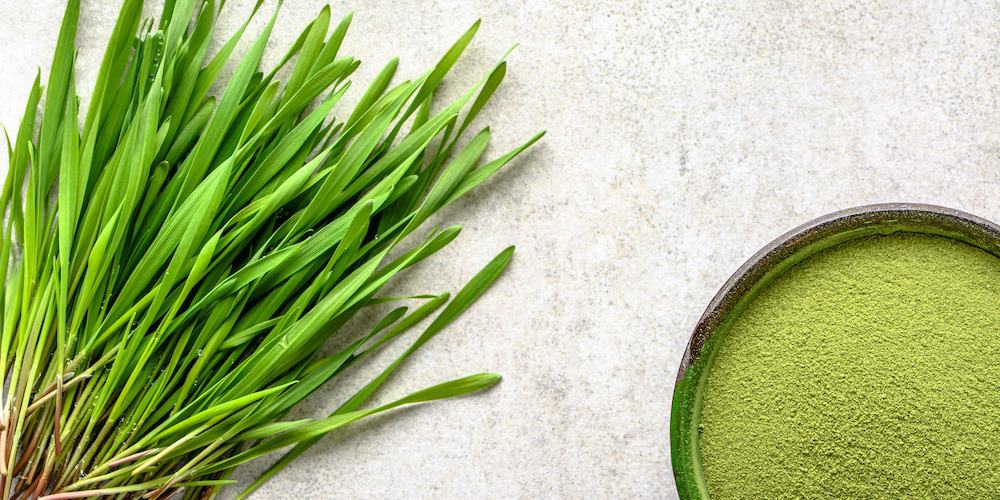BENEFITS OF BARLEY GRASS
✓ Detoxifies the body
✓ Helps with weight loss
✓ Improves diabetes
✓ Relieves depression
✓ Potentially anti-cancer
What is barley grass?
Barley (Hordeum vulgare) is a cereal belonging to the grass family, like wheat, oats or millet. Native to the Middle East and Western Asia, it has been cultivated by humans since 8000 BC. It is mainly consumed for its grains intended for human and animal consumption. But barley is also grown for its young shoots called ‘barley grass’.
Barley grass refers to the young shoot that is harvested before flowering and the formation of grains on the ear. At this stage, it has a beautiful green color due to its high concentration of chlorophyll.
It also contains more nutrients than the mature plant: amino acids, vitamins, antioxidants, minerals, fiber… Finally, unlike the grains, barley grass does not contain gluten and is therefore suitable for people with celiac disease.
Once harvested, it is ground into powder or consumed as juice. Valued for its fresh and “green” taste, similar to that of spinach, it also has many health benefits. Thus, it helps detoxify the body, aids weight loss, improves diabetes and relieves depression. It also has potential anti-cancer properties.
30 à 40 % de la production mondiale d’orge sont destinés à l’élaboration de malt pour la brasserie. On parle alors d’orge brassicole qui entre dans la fabrication de la bière, comme ici en Bretagne. 55 % de la production sont ensuite consacrés à l’alimentation animale et le restant revient à l’alimentation humaine. Le marché de l’herbe d’orge est donc encore très peu développé. Mais il est aujourd’hui porté par une volonté de manger mieux.
Nutritional composition
- Acides aminés
- Vitamines : pro-vitamine A, B1, B2, B3, B5, B6, B9, C, E, K
- Minéraux et oligo-éléments : calcium, cuivre, fer, potassium, magnésium, phosphore
- Protéines
- Fibres
- Glucides
- Actifs antioxydants : chlorophylle, superoxyde dismutase, catalase, proanthocyanidines

Benefits of barley grass
💎 Detoxifies the body
Consuming barley grass is useful for detoxifying the body. Indeed, like nettle and spirulina, it contains a large amount of chlorophyll. This green antioxidant pigment promotes the elimination of accumulated toxins and heavy metals.
Chlorophyll cleanses the entire body, and more particularly the liver, kidneys, colon and intestinal walls. It thus supports the various excretory organs in the elimination process and prevents the development of certain diseases.
This review from the Yunnan Academy of Agricultural Sciences (China) confirms the detoxifying effects of barley grass and shows its benefits for chronic diseases.
🏃🏻♂️ Helps with weight loss
Barley grass is a natural source of soluble and insoluble fiber. These help with appetite control and weight management.
Soluble fibers turn into a viscous gel once in the stomach. They then promote a feeling of fullness and help reduce snacking throughout the day.
Insoluble fibers, on the other hand, swell on contact with water. They speed up intestinal transit, increase stool bulk and contribute to a flat stomach.
This study from the Andhra Pradesh Institute of Pharmaceutical Technology (India), conducted on rats, demonstrates the anti-obesity effects of barley grass juice.
🍭 Improves diabetes
Due to its high soluble fiber content, barley grass may be useful for type 2 diabetes. In various studies, it has been shown to reduce blood sugar levels and improve insulin sensitivity.
It notably contains beta-glucans, soluble fibers that slow the absorption of carbohydrates and prevent blood sugar spikes after meals. In addition, it improves the lipid profile of people with diabetes by lowering LDL cholesterol (or “bad cholesterol”) and increasing HDL cholesterol (or “good cholesterol”).
This study from Maharaja Sayajirao University of Baroda (India), conducted in diabetic patients, shows the benefits of barley grass on the disease.
🧘🏻♀️ Relieves depression
Consumption of barley grass also has beneficial effects on mental well-being. Thus, it helps relieve depression and various associated symptoms: stress, chronic fatigue, loss of concentration and memory…
On the one hand, it is an alkaline food, meaning that it helps the body maintain an acid-base balance. This balance is important because excess acidity can have harmful consequences on the central nervous system : depression, irritability, anxiety…
On the other hand, it contains nutrients essential for the maintenance of cognitive functions such as vitamin E, vitamin C, and magnesium.
This study from Chiba University (Japan), conducted on mice, shows the antidepressant effect of barley grass.
🔬 Potentially anti-cancer
Barley grass has anti-cancer potential due to its richness in antioxidants. Thus, its consumption appears to inhibit the proliferation of cancer cells. It also induces necrosis of diseased cells, leading to their death.
This study from the Lublin Institute of Rural Health (Poland), carried out directly in the laboratory, shows the positive effects of barley grass on colon cancer.

How to consume barley grass?
Barley grass powder
Once harvested, fresh barley shoots are dried and then ground into powder. The result is a fine green powder that is easy to consume and use. It can also be pressed barley grass juice that is then dehydrated at low temperature. The latter has a stronger taste and contains less fiber.
To consume barley grass powder, you can simply dissolve it in a large glass of water, with honey or lemon juice to improve its taste. It can also be mixed into yogurt, into your juices, smoothies and healthy drinks at home. Finally, this powder is ideal for making « energy balls », accompanied by dried fruit, goji berries, chia seeds…
Barley grass juice
You can also find fresh barley grass juice, extracted from young pressed shoots. It can be enjoyed as-is or in a smoothie. Its very « green » taste may not be to everyone’s liking. But it can be mellowed by combining the juice with carrot or apple.

Consume sustainably: prioritize local, organic, and fair-trade barley grass
✓ Russia, France and Germany are the world’s leading barley producers. It is the 3rd most widely cultivated cereal in France (after wheat and corn) with about 12,000 tonnes produced each year. Production is concentrated in the center and north of the country.
✓ If you can, favor French-origin barley grass grown organically. Fair trade supply chains also help support the work of small producers.
Dosage
The recommended dosage is 1 teaspoon of barley grass twice a day.
Take as a one-month course, preferably before meals.
Contraindications and side effects
Consumption of barley grass presents certain contraindications :
- Par mesure de précaution, elle est déconseillée aux femmes enceintes et allaitantes et aux jeunes enfants ;
- Les personnes souffrant de diabète doivent demander conseil à leur médecin avant d’en consommer ;
- Sa consommation peut interagir avec certains médicaments (antidiabétiques).
Excessive consumption may cause certain side effects :
- Maux de tête
- Nausées
- Réaction allergique
If you experience side effects, stop taking it and consult a doctor.

Report prepared by Julia Perez
Sources and scientific studies
Huw Jones, Peter Civáň, James Cockram, Fiona J Leigh, Lydia MJ Smith, Martin K Jones, Michael P Charles, José-Luis Molina-Cano, Wayne Powell, Glynis Jones, Terence A Brown, 2011. Evolutionary history of barley cultivation in Europe revealed by genetic analysis of extant landraces.
Yawen Zeng, Xiaoying Pu, Jiazhen Yang, Juan Du, Xiaomeng Yang, Xia Li, Ling Li, Yan Zhou, Tao Yang, 2018. Preventive and Therapeutic Role of Functional Ingredients of Barley Grass for Chronic Diseases in Human Beings.
Jhansyrani Thatiparthi, Sujatha Dodoala, Bharathi Koganti, Prasad Kvsrg, 2019. Barley grass juice (Hordeum vulgare L.) inhibits obesity and improves lipid profile in high fat diet-induced rat model.
Shonima Venugopal, Uma Iyer, 2010. Management of diabetic dyslipidemia with subatmospheric dehydrated barley grass powder.
Katsunori Yamaura, Noriyuki Nakayama, Maki Shimada, Yuanyuan Bi, Hideki Fukata, Koichi Ueno, 2012. Antidepressant-like effects of young green barley leaf (Hordeum vulgare L.) in the mouse forced swimming test.
Katarzyna Kawka, Marta Kinga Lemieszek, Wojciech Rzeski, 2019. Chemopreventive properties of young green barley extracts in in vitro model of colon cancer.



